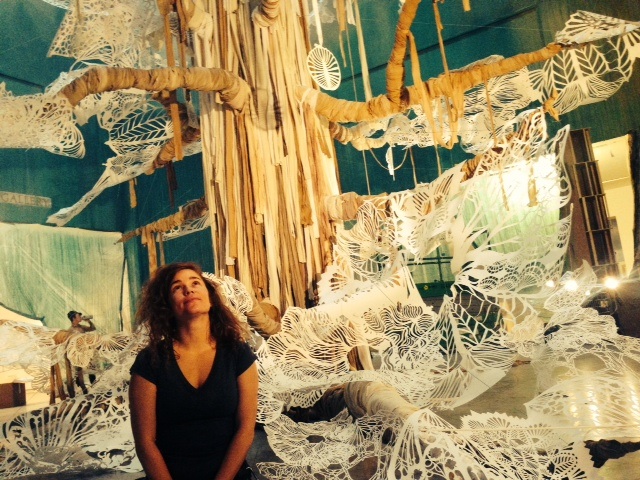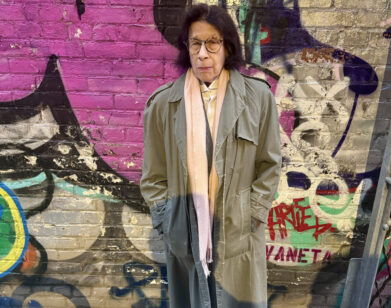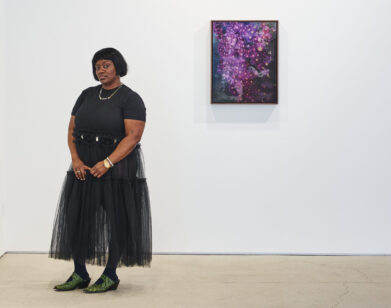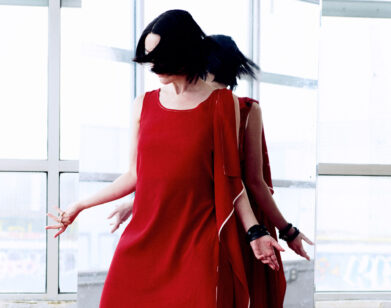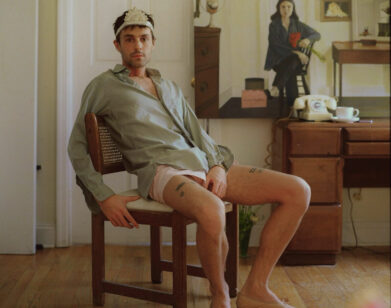Swoon’s Mother Lode
Caledonia Dance Curry, widely known as the street artist Swoon, bounces and glows with the paint-splattered youthful optimism of an art school undergrad, despite the recent and somewhat sudden passing of her mother, frequent trips to a ravaged but recovering Haiti for her “Konbit Shelter” sustainable housing project—and of course, the mounting pressure of her massive upcoming solo show “Submerged Motherlands” opening this Friday, April 11, at The Brooklyn Museum.
The centerpiece of this site-specific show is a massive 60-foot tree, draped with layered and impossibly long fabrics dyed in rich earth tones and crowned with intricately cut white paper foliage, erected in the center of the museum’s massive, skylit, fifth-floor rotunda. The walls, assaulted in dark blue and green paint with an assortment of fire extinguishers, serve as a backdrop to what is in many ways a multi-media retrospective of Swoon’s varied career as an artist. Her found-object sailing barges, the formerly floating installations from her “Miss Rockaway Armada” and “Swimming Cities of Serenissima” voyages, will be on full display, while a collection of her trademark larger-than-life paper line portraits float in the space like the wayward ghosts of Hogwarts. The showpiece among these stunning works is a heart-wrenching depiction of her emaciated mother, originally completed just moments before her passing.
Since moving to New York from Daytona Beach, Florida at the age of 18 to attend Pratt Institute in Brooklyn, Curry has built an impressive global portfolio of striking wheat paste street prints, each one a unique exercise in urban decay and voyeurism. Swoon’s career as an artist and activist seems to be focused on maintaining a sensitive dialogue between humans and their surroundings, whether it’s in a highly gentrified neighborhood in Brooklyn or the partially abandoned town of Braddock, Pennsylvania, where Swoon and a collection of other motivated artists are turning an old church from the late 1800s into an arts based community center for the ongoing project “Transformazium.”
We caught up with Swoon less than a week into the show’s installation at a cozy café near The Brooklyn Museum to discuss the responsibilities (or lack thereof) in sailing in the wake of Mark Twain, her Haitian goddaughter Bessie, the teachings of Gabor Maté and the shifting cultural perspective on addiction, and the childlike awe of Jeffrey Deitch, as well as her long overdue and highly emotional Brooklyn homecoming.
KURT MCVEY: I watched your TEDx talk, which was excellent. Tell us about that experience; I’ve spoken to a few artists who have had mixed reviews in regards to working within the TED system.
SWOON: In a lot of ways, it was more of a Pratt event than a TED event. There were some great speakers and some amazingly unprepared speakers. It was the first time I’ve ever done a timed speech like that, and I wasn’t sure how to create a narrative arch for myself. Luckily, I met these guys who do this project called Word Up that’s all about hip-hop and youth and Brooklyn. Ebenezer Bond, who started the nonprofit, helped me a lot. We sat down for a coffee and started chatting, and somehow he tricked me into formulating some ideas. It was all pretty straightforward, kind of art focused. Though I did do another talk recently where I gave this super intense familial history.
MCVEY: Was that also for TED?
SWOON: No, it was this other big conference type thing called The Feast or Feast On Good. I actually wrote an op-ed for CNN that was built from that speech. It was about addiction, and my mom just died this year so I decided to talk about her. It was only when I forced myself to examine her life story that I was able to fully articulate my own.
MCVEY: How did you feel about using outlets outside of your art to process those emotions?
SWOON: It was strange. There was a tagline on CNN that said, “Caledonia Curry Forgives Her Mother.” I was like, “Is that news?” You have to understand; my parents were total heroin-addicted mental lunatics. My dad cleaned up but my mom was never quite able to. I never really understood the concept of mental illness or physical addiction until a few years ago, when I stumbled upon this Canadian doctor named Gabor Maté who shifted my perspective on the whole issue.
MCVEY: Does he subscribe to this idea that addiction is a disease?
SWOON: The idea that addiction is a disease often focuses on the genetics and his viewpoint is that it’s mostly developmental. He argues that we need to understand people’s actions in a different context so that we’re less hateful or judgmental towards those who have experienced traumatic situations and are therefore at much greater risk. It’s not so much about the individual taking personal responsibility as much as it is about understanding that we as a culture can’t simply wash our hands of these people.
MCVEY: Growing up with this prevailing ideology and witnessing your parent’s struggles, were you nervous that you had this same susceptibility in your genes?
SWOON: Definitely. It wasn’t just addiction. There was a lot of mental illness in my family. As a teenager, I was positive that I was going to develop multiple personality disorder. It was obviously in the genes, but it didn’t happen. It’s just me. Here I am! [both laugh] So there’s a little of that “creativity saved my life” narrative in there, but I think more so, it’s just that my life experiences have been drastically different.
MCVEY: What’s your relationship with your dad like?
SWOON: It’s good. He’s in Florida.
MCVEY: Let’s talk about “Konbit Shelter,” your ongoing project in Haiti. When was your last trip?
SWOON: I just got back about two months ago. We go about three or four times a year.
MCVEY: So you’re a familiar face down there at this point.
SWOON: Oh yeah. I have a Haitian goddaughter, kind of on accident really. Her name is Bessie, after the blues singer Bessie Smith. When she was born her parents asked me for a name suggestion. I said, “Why not Bessie?,” and they immediately went with it.
MCVEY: Was there ever a point in Haiti when things became too physically or emotionally challenging?
SWOON: Oh yeah, our first time. We were just a small group of artists, so we knew we needed to be as localized as possible, instead of taking on the entirety of these sprawling tent cities. When we started the build, we were just working like maniacs. Our bodies were destroyed from the physical labor. We didn’t know when we were going to finish, so we didn’t have plane tickets home. Also, it was the rainy season, so it was hot as a motherfucker. We all started breaking out in these crazy rashes. We were falling apart, and you felt the emotional trauma everywhere. Buildings collapsed, the economy collapsed, family members were lost, and everyone was shaken or scared. Even though we weren’t in the worst of the worst, you couldn’t help but be affected. We got the project to a point where we were comfortable that others could take over until we got back. But yeah, that first time, it almost broke us. We had to go.
MCVEY: One of my favorite stories you tell is the homeless man who found one of your street-art viewfinder pieces and lovingly shared it with everyone in the neighborhood, referring to it as “his secret.” You spoke of how transformative that exchange was for you as an artist. I was wondering if you’ve had an experience on par with that in any of your more recent projects.
SWOON: The whole time we were on the Mississippi River was like that. It was one of the most incredible things I’ve ever done.
MCVEY: That was “The Miss Rockaway Armada.” Did you have any classic Mark Twain-inspired American revelations?
SWOON: There’s just so many! Though right when you said that, I was remembering this one night when we were about to go through one particularly massive lock and dam. All the boats were slowing down and converging, the sun was setting, and we all started jumping off the boats and into the water when all of a sudden, hundreds and hundreds of dragonflies started flying and buzzing all around us. We were speechless.
MCVEY: Your own Gabriel García Márquez moment.
SWOON: Pure joy, Mississippi magical a hundred times a day. [laughs] When we were in Venice with “The Swimming Cities of Serenissima,” it was a total dream, but before that, we did it in New York. New Yorkers were the toughest; they were all like, “Call the Coast Guard!”
MCVEY: [laughs] You sailed down the Hudson right?
SWOON: New York was “Swimming Cities of Switchback Sea.” I did that with Deitch Projects.
MCVEY: If Warhol doesn’t come up in these interviews, Jeffrey Deitch does.
SWOON: Deitch is so wild. I’m thoroughly in his camp. He’s a controversial figure, but he supported me creatively from such a young age. What people don’t realize about him—and this ties into your “secret” question—is that when he walks into your installation and it’s popping off, he goes through a transformation. He becomes an awestruck child when he really connects to a work. To see him truly come alive is amazing.
MCVEY: So now you’re back in New York and you’re about to do this huge solo show, “Submerged Motherlands” at The Brooklyn Museum. Tell us about that title.
SWOON: I had been thinking a lot about global warming. When I first built the boats, I had visions of a city breaking off into a million pieces in a flood and all sorts of animals and people floating away. In 2008, no one wanted to talk about it, but then in 2012, Hurricane Sandy hit and that kind of reignited the dialogue. When I spoke to The Brooklyn Museum, I knew that I wanted the boats to have one more moment, but not as boats, but as sculptures. Have you heard of this place called Doggerland?
MCVEY: No.
SWOON: It’s this submerged strip of land that used to connect England with Denmark. It was the most populated area in Europe about 8,000 years ago, until the end of the last ice age when everyone was flooded out.
MCVEY: Sounds like an Atlantis type story.
SWOON: Total Atlantis! So I was thinking about these submerged and lost places when somewhat suddenly, my mother died—we had a few months together, though it was an intense process of reckoning and forgiveness which somehow lead me to this interesting journey where I became somewhat obsessed with aboriginal artists and cultures from Brazil and Australia. I was fascinated by how they hang onto their land and live sustainably while facing this relentless industrial machine. This show is about connecting the very personal experience of losing my own mother with this larger idea of fighting to maintain a link with one’s own motherland.
MCVEY: Have you ever drawn your mother?
SWOON: I did, while she was sick. I had to. Some drawings you can draw whenever, and some you have to do right then and there. A version of it will be in the show.
MCVEY: What does New York mean to you at the moment?
SWOON: I still love New York and feel most at home here, despite how much it’s changed. It’s more a port or a hub for me now. Sometimes people will ask me, “What’s your favorite place in New York?” and I’ll say, “A place that doesn’t exist anymore.”
SWOON’S “SUBMERGED MOTHERLANDS” IS ON VIEW AT THE BROOKLYN MUSEUM STARTING TOMORROW, APRIL 11, THROUGH AUGUST 24.

